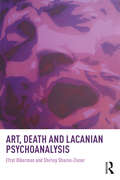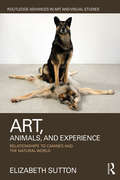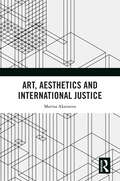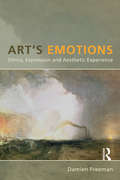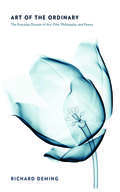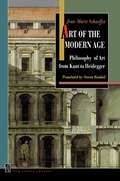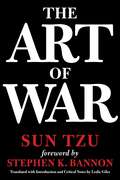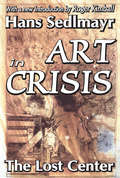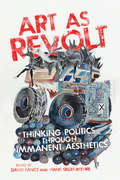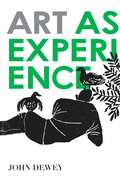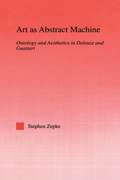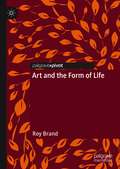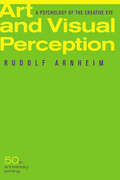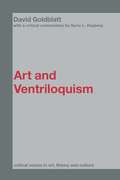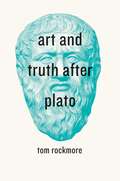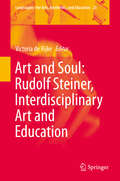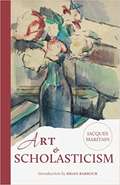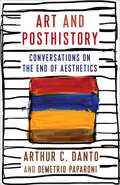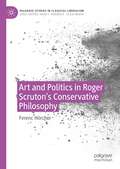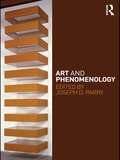- Table View
- List View
Art, Death and Lacanian Psychoanalysis
by Efrat Biberman Shirley Sharon-ZisserArt, Death and Lacanian Psychoanalysis examines the relationship between art and death from the perspective of Lacanian psychoanalysis. It takes a unique approach to the topic by making explicit reference to the death drive as manifest in theories of art and in artworks. Freud’s treatment of death focuses not on the moment of biological extinction but on the recurrent moments in life which he called "the death drive" or the "compulsion to repeat": the return precisely of what is most unbearable for the subject. Surprisingly, in some of its manifestations, this painful repetition turns out to be invigorating. It is this invigorating repetition that is the main concern of this book, which demonstrates the presence of its manifestations in painting and literature and in the theoretical discourse concerning them from the dawn of Western culture to the present. After unfolding the psychoanalytical and philosophical underpinnings for the return of the death drive as invigorating repetition in the sphere of the arts, the authors examine various aspects of this repetition through the works of Gerhard Richter, Jeff Wall, and contemporary Israeli artists Deganit Berest and Yitzhak Livneh, as well as through the writings of Virginia Woolf and James Joyce. First to articulate the stimulating aspect of the death drive in its relation to the arts and the conception of art as a varied repetition beyond a limit, Art, Death and Lacanian Psychoanalysis will be indispensable to psychoanalysts, scholars of art theory and aesthetics and those studying at the intersection of art and psychoanalysis.
Art, Animals, and Experience: Relationships to Canines and the Natural World (Routledge Advances in Art and Visual Studies)
by Elizabeth SuttonElizabeth Sutton, using a phenomenological approach, investigates how animals in art invite viewers to contemplate human relationships to the natural world. Using Rembrandt van Rijn’s etching of The Presentation in the Temple (c. 1640), Joseph Beuys’s social sculpture I Like America and America Likes Me (1974), archaic rock paintings at Horseshoe Canyon, Canyonlands National Park, and examples from contemporary art, this book demonstrates how artists across time and cultures employed animals to draw attention to the sensory experience of the composition and reflect upon the shared sensory awareness of the world.
Art, Aesthetics and International Justice
by Marina AksenovaThis book demonstrates that art is implicit in the process of administration of international justice. The diverse nature of recent global threats as well as an overwhelming pull towards isolationism and nationalism challenge the dominant deterrence paradigm of international governance created in the aftermath of the Second World War. An alternative model is to focus on cooperation, and not deterrence, as a guiding operational principle.This volume focuses on the theoretical component linking justice with aesthetics as well as on the practical manifestation of such connection evident, inter alia, in the rhetoric of international courts, their architectural design and their commemorative practices expressed by the practice of symbolic reparations adopted by some of the courts. The underlying premise of the book is that international justice requires new vocabulary and new approaches, which can be derived from the study of aesthetics. It is held that exploring the aesthetical dimension of international justice contributes to the discussion on the foundations of its authority and the grounds for compliance with it. The work engages deeply with the theory of aesthetics developed by Immanuel Kant and Abhinavagupta, a Kashmiri critic, philosopher and scholar writing in the early eleventh century.The book will be of interest to academics and researchers working in the areas of Legal Philosophy, International Criminal Justice and International Law and International Relations.
Art's Emotions: Ethics, Expression and Aesthetic Experience
by Damien FreemanDespite the very obvious differences between looking at Manet’s Woman with a Parrot and listening to Elgar’s Cello Concerto, both experiences provoke similar questions in the thoughtful aesthete: why does the painting seem to express reverie and the music, nostalgia? How do we experience the reverie and nostalgia in such works of art? Why do we find these experiences rewarding in similar ways? As our awareness of emotion in art, and our engagement with art’s emotions, can make such a special contribution to our life, it is timely for a philosopher to seek to account for the nature and significance of the experience of art’s emotions. Damien Freeman develops a new theory of emotion that is suitable for resolving key questions in aesthetics. He then reviews and evaluates three existing approaches to artistic expression, and proposes a new approach to the emotional experience of art that draws on the strengths of the existing approaches. Finally, he seeks to establish the ethical significance of this emotional experience of art for human flourishing. Freeman challenges the reader not only to consider how art engages with emotion, but how we should connect up our answers to questions concerning the nature and value of the experiences offered by works of art.
Art of the Ordinary: The Everyday Domain of Art, Film, Philosophy, and Poetry
by Richard DemingCutting across literature, film, art, and philosophy, Art of the Ordinary is a trailblazing, cross-disciplinary engagement with the ordinary and the everyday. Because, writes Richard Deming, the ordinary is always at hand, it is, in fact, too familiar for us to perceive it and become fully aware of it. The ordinary he argues, is what most needs to be discovered and yet is something that can never be approached, since to do so is to immediately change it.Art of the Ordinary explores how philosophical questions can be revealed in surprising places—as in a stand-up comic’s routine, for instance, or a Brillo box, or a Hollywood movie. From negotiations with the primary materials of culture and community, ways of reading "self" and "other" are made available, deepening one’s ability to respond to ethical, social, and political dilemmas. Deming picks out key figures, such as the philosophers Stanley Cavell, Arthur Danto, and Richard Wollheim; poet John Ashbery; artist Andy Warhol; and comedian Steven Wright, to showcase the foundational concepts of language, ethics, and society. Deming interrogates how acts of the imagination by these people, and others, become the means for transforming the alienated ordinary into a presence of the everyday that constantly and continually creates opportunities of investment in its calls on interpretive faculties.In Art of the Ordinary, Deming brings together the arts, philosophy, and psychology in new and compelling ways so as to offer generative, provocative insights into how we think and represent the world to others as well as to ourselves.
Art of the Modern Age: Philosophy of Art from Kant to Heidegger (New French Thought Series #2)
by Jean-Marie SchaefferThis is a sweeping and provocative work of aesthetic theory: a trenchant critique of the philosophy of art as it developed from the eighteenth century to the early twentieth century, combined with a carefully reasoned plea for a new and more flexible approach to art.Jean-Marie Schaeffer, one of France's leading aestheticians, explores the writings of Kant, Schlegel, Novalis, Hegel, Schopenhauer, Nietzsche, and Heidegger to show that these diverse thinkers shared a common approach to art, which he calls the "speculative theory." According to this theory, art offers a special kind of intuitive, quasi-mystical knowledge, radically different from the rational knowledge acquired by science. This view encouraged theorists to consider artistic geniuses the high-priests of humanity, creators of works that reveal the invisible essence of the world. Philosophers came to regard inexpressibility as the aim of art, refused to consider second-tier creations genuine art, and helped to create conditions in which the genius was expected to shock, puzzle, and mystify the public. Schaeffer shows that this speculative theory helped give birth to romanticism, modernism, and the avant-garde, and paved the way for an unfortunate divorce between art and enjoyment, between "high art" and popular art, and between artists and their public.Rejecting the speculative approach, Schaeffer concludes by defending a more tolerant theory of art that gives pleasure its due, includes popular art, tolerates less successful works, and accounts for personal tastes."[A] remarkable work.... [Schaeffer's] writing is governed by ... the ideals of clarity and consequence, the ideas of logic, truth, and evidence.... Schaeffer is so precise and unrelenting a philosophical critic that one wonders how some of the philosophies he anatomizes here can possibly survive the operation."--From the foreword by Arthur C. Danto
Art of War
by Sun Tzu&“The art of war is of vital importance to the State. It is a matter of life and death, a road either to safety or to ruin. Hence it is a subject of inquiry which can on no account be neglected.&” There is a reason why five-star generals and Fortune 500 CEOs alike have consulted this classic book on the planning and conduct of military operations. Written in China more than two thousand years ago, The Art of War is an ancient Chinese military treatise attributed to Sun Tzu, a high-ranking military general, strategist, and tactician. The Art of War remains one of the most quoted and referenced how-to books ever written. Now, with a foreword by Stephen K. Bannon, this seminal work takes on renewed significance, offering a blueprint for success amidst the chaos of contemporary challenges. As we navigate the complexities of the twenty-first century, The Art of War stands as a beacon of strategic wisdom, guiding us through the turbulent waters of life, leadership, and conflict. Its profound truths, encapsulated in thirteen timeless chapters, illuminate the path to victory in any arena, whether it be the cutthroat world of business, the arena of politics, or the theater of war.
Art in Crisis: The Lost Center
by Hans SedlmayrThe history of art from the early nineteenth century on- ward is commonly viewed as a succession of conflicts between innovatory and established styles that culminated in the formalism and aesthetic autonomy of high modernism. In Art and Crisis, first published in 1948, Hans Sedlmayr argues that the aesthetic disjunctures of modern art signify more than matters of style and point to much deeper processes of cultural and religious disintegration. As Roger Kimball observes in his informative new introduction, Art in Crisis is as much an exercise in cultural or spiritual analysis as it is a work of art history. Sedlmayr's reads the art of the last two centuries as a fever chart of the modern age in its greatness and its decay. He discusses the advent of Romanticism with its freeing of the imagination as a conscious sundering of art from humanist and religious traditions with the aesthetic treated as a category independent of human need. Looking at the social purposes of architecture, Sedlmayr shows how the landscape garden, the architectural monument, and the industrial exhibition testified to a new relationship not only between man and his handiwork but also between man and the forces that transcend him. In these institutions man deifies his inventive powers with which he hopes to master and supersede nature. Likewise, the art museum denies transcendence through a cultural leveling in which Heracles and Christ become brothers as objects of aesthetic contemplation. At the center of Art in Crisis is the insight that, in art as in life, the pursuit of unqualified autonomy is in the end a prescription for disaster, aesthetic as well as existential. Sedlmayr writes as an Augustinian Catholic. For him, the underlying motive for the pursuit of autonomy is pride. The lost center of his subtitle is God. The dream of autonomy, Sedlmayr argues, is for finite, mortal creatures, a dangerous illusion. The book invites serious analysis from art cri
Art before the Law
by Ruth RonenEver since Plato expelled the poets from his ideal state, the ethics of art has had to confront philosophy's denial of art's morality. In Art before the Law, Ruth Ronen proposes a new outlook on the ethics of art by arguing that art insists on this tradition of denial, affirming its singular ethics through negativity.Ronen treats the mechanism of negation as the basis for the relationship between art and ethics. She shows how, through moves of denial, resistance, and denouncement, art exploits its negative relation to morality. While deception, fiction, and transgression allegedly locate art outside morality and ethics, Ronen argues they enable art to reveal the significance of the moral law, its origins, and the idea of the good. By employing the thought of Freud and Lacan, Ronen reconsiders the aesthetic tradition from Plato through Kant and later philosophers of art in order to establish an ethics of art. An interdisciplinary study, Art before the Law is sure to be of interest both to academic philosophers and to those interested in psychoanalytic theory and practice.
Art as Revolt: Thinking Politics through Immanent Aesthetics
by Hans Skott-Myhre David FancyHow can we imagine a future not driven by capitalist assumptions about humans and the wider world? How are a range of contemporary artistic and popular cultural practices already providing pathways to post-capitalist futures? Authors from a variety of disciplines answer these questions through writings on blues and hip hop, virtual reality, post-colonial science fiction, virtual gaming, riot grrrls and punk, raku pottery, post-pornography fanzines, zombie films, and role playing. The essays in Art as Revolt are clustered around themes such as technology and the future, aesthetics and resistance, and ethnographies of the self beyond traditional understandings of identity. Using philosophies of immanence – describing a system that gives rise to itself, independent of outside forces – drawn from a rich and evolving tradition that includes Spinoza, Nietzsche, Deleuze, and Braidotti, the authors and editors provide an engrossing range of analysis and speculation. Together the essays, written by experts in their fields, stage an important collective, transdisciplinary conversation about how best to talk about art and politics today. Sophisticated in its theoretical and philosophical premises, and engaging some of the most pressing questions in cultural studies and artistic practice today, Art as Revolt does not provide comfortable closure. Instead, it is understood by its authors to be a “Dionysian machine,” a generator of open-ended possibility and potential that challenges readers to affirm their own belief in the futures of this world. Contributors include Timothy J. Beck (University of West Georgia) Mark Bishop (Independent Scholar), Dave Collins (University of West Georgia), David Fancy (Brock University), Veronica Pacini-Ketchabaw (University of Western Ontario), Malisa Kurtz (Independent Scholar), Nicole Land (Ryerson University), Eric Lochhead (Youth Author Calgary Alberta) , Douglas Ord (Doctoral Student University of Western Ontario), Peter Rehberg (Institute for Cultural Inquiry—Berlin), Chris Richardson (Young Harris College), Hans Skott-Myhre (Kennesaw State University), Kathleen Skott-Myhre (University of West Georgia), and Joanna Wasiak (Independent Scholar).
Art as Revolt: Thinking Politics through Immanent Aesthetics
by David Fancy and Hans Skott-MyhreHow can we imagine a future not driven by capitalist assumptions about humans and the wider world? How are a range of contemporary artistic and popular cultural practices already providing pathways to post-capitalist futures? Authors from a variety of disciplines answer these questions through writings on blues and hip hop, virtual reality, post-colonial science fiction, virtual gaming, riot grrrls and punk, raku pottery, post-pornography fanzines, zombie films, and role playing. The essays in Art as Revolt are clustered around themes such as technology and the future, aesthetics and resistance, and ethnographies of the self beyond traditional understandings of identity. Using philosophies of immanence – describing a system that gives rise to itself, independent of outside forces – drawn from a rich and evolving tradition that includes Spinoza, Nietzsche, Deleuze, and Braidotti, the authors and editors provide an engrossing range of analysis and speculation. Together the essays, written by experts in their fields, stage an important collective, transdisciplinary conversation about how best to talk about art and politics today. Sophisticated in its theoretical and philosophical premises, and engaging some of the most pressing questions in cultural studies and artistic practice today, Art as Revolt does not provide comfortable closure. Instead, it is understood by its authors to be a “Dionysian machine,” a generator of open-ended possibility and potential that challenges readers to affirm their own belief in the futures of this world. Contributors include Timothy J. Beck (University of West Georgia), Mark Bishop (Independent Scholar), Dave Collins (University of West Georgia), David Fancy (Brock University), Veronica Pacini-Ketchabaw (University of Western Ontario), Malisa Kurtz (Independent Scholar), Nicole Land (Ryerson University), Eric Lochhead (Youth Author Calgary Alberta), Douglas Ord (Doctoral Student University of Western Ontario), Joanna Perkins (Independent Scholar), Peter Rehberg (Institute for Cultural Inquiry—Berlin), Chris Richardson (Young Harris College), Hans Skott-Myhre (Kennesaw State University), and Kathleen Skott-Myhre (University of West Georgia).
Art as Experience
by John DeweyBased on John Dewey's lectures on esthetics, delivered as the first William James Lecturer at Harvard in 1932, Art as Experience has grown to be considered internationally as the most distinguished work ever written by an American on the formal structure and characteristic effects of all the arts: architecture, sculpture, painting, music, and literature.
Art as Abstract Machine: Ontology and Aesthetics in Deleuze and Guattari
by Stephen ZepkeFirst Published in 2005. Routledge is an imprint of Taylor & Francis, an informa company.
Art and the Form of Life
by Roy BrandArt and the Form of Life takes a classic theme—philosophy as the art of living—and gives it a contemporary twist. The book examines a series of watershed moments in artistic practice alongside philosophers’ most enduring questions about the way we live. Coupling Tino Sehgal with Wittgenstein, cave art with Foucault, Stanley Kubrick with Nietzsche, and the Bauhaus with Walter Benjamin, the book animates the idea that life is literally ours to make. It reflects on universal themes that connect the long histories of art and philosophy, and it does so using a contemporary approach. Drawing on great philosophical works, it argues that life practiced as an art form affords an experience of meaning, in the sense that it is engaging, creative, and participatory. It thus effects a fundamental renewal of experience.
Art and the Church: Ecclesiastical Encounters with Contemporary Art
by Jonathan Koestle-CateA vibrant critical exchange between contemporary art and Christianity is being increasingly prompted by an expanding programme of art installations and commissions for ecclesiastical spaces. Rather than 'religious art' reflecting Christian ideology, current practices frequently initiate projects that question the values and traditions of the host space, or present objects and events that challenge its visual conventions. In the light of these developments, this book asks what conditions are favourable to enhancing and expanding the possibilities of church-based art, and how can these conditions be addressed? What viable language or strategies can be formulated to understand and analyse art's role within the church? Focusing on concepts drawn from anthropology, comparative religion, art theory, theology and philosophy, this book formulates a lexicon of terms built around the notion of encounter in order to review the effective uses and experience of contemporary art in churches. The author concludes with the prognosis that art for the church has reached a critical and decisive phase in its history, testing the assumption that contemporary art should be a taken-for-granted element of modern church life. Art and the Church: A Fractious Embrace uniquely combines conceptual analysis, critical case studies and practical application in a rigorous and inventive manner, dealing specifically with contemporary art of the past twenty-five years, and the most recent developments in the church's policies for the arts.
Art and Visual Perception, Second Edition: A Psychology of the Creative Eye
by Rudolf ArnheimSince its publication fifty years ago, this work has established itself as a classic. It casts the visual process in psychological terms and describes the creative way one's eye organizes visual material according to specific psychological premises. In 1974 this book was revised and expanded, and since then it has continued to burnish Rudolf Arnheim's reputation as a groundbreaking theoretician in the fields of art and psychology.
Art and Ventriloquism (Critical Voices in Art, Theory and Culture)
by David GoldblattThis exciting collection of David Goldblatt's essays, available for the first time in one volume, uses the metaphor of ventriloquism to help understand a variety of art world phenomena. It examines how the vocal vacillation between ventriloquist and dummy works within the roles of artist, artwork and audience as a conveyance to the audience of the performer's intentions, emotions and beliefs through a created performative persona. Considering key works, including those of Nietzsche, Foucault, Socrates, Derrida, Cavell and Wittgenstein, Goldblatt examines how the authors use the framework of ventriloquism to construct and negate issues in art and architecture. He ponders 'self-plagiarism'; why the classic philosopher cannot speak for himself, but must voice his thoughts through fictional characters or inanimate objects and works. With a close analysis of two ventriloquist paintings by Jasper Johns and Paul Klee, a critical commentary by Garry L. Hagberg, and preface by series editor Saul Ostrow, Goldblatt's thoroughly fascinating book will be an invaluable asset to students of cultural studies, art, and philosophy.
Art and Truth after Plato
by Tom RockmoreDespite its foundational role in the history of philosophy, Plato's famous argument that art does not have access to truth or knowledge is now rarely examined, in part because recent philosophers have assumed that Plato's challenge was resolved long ago. In Art and Truth after Plato, Tom Rockmore argues that Plato has in fact never been satisfactorily answered--and to demonstrate that, he offers a comprehensive account of Plato's influence through nearly the whole history of Western aesthetics. Rockmore offers a cogent reading of the post-Platonic aesthetic tradition as a series of responses to Plato's position, examining a stunning diversity of thinkers and ideas. He visits Aristotle's Poetics, the medieval Christians, Kant's Critique of Judgment, Hegel's phenomenology, Marxism, social realism, Heidegger, and many other works and thinkers, ending with a powerful synthesis that lands on four central aesthetic arguments that philosophers have debated. More than a mere history of aesthetics, Art and Truth after Plato presents a fresh look at an ancient question, bringing it into contemporary relief.
Art and Truth after Plato
by Tom RockmoreDespite its foundational role in the history of philosophy, Plato’s famous argument that art does not have access to truth or knowledge is now rarely examined, in part because recent philosophers have assumed that Plato’s challenge was resolved long ago. In Art and Truth after Plato, Tom Rockmore argues that Plato has in fact never been satisfactorily answered—and to demonstrate that, he offers a comprehensive account of Plato’s influence through nearly the whole history of Western aesthetics. Rockmore offers a cogent reading of the post-Platonic aesthetic tradition as a series of responses to Plato’s position, examining a stunning diversity of thinkers and ideas. He visits Aristotle’s Poetics, the medieval Christians, Kant’s Critique of Judgment, Hegel’s phenomenology, Marxism, social realism, Heidegger, and many other works and thinkers, ending with a powerful synthesis that lands on four central aesthetic arguments that philosophers have debated. More than a mere history of aesthetics, Art and Truth after Plato presents a fresh look at an ancient question, bringing it into contemporary relief.
Art and Soul: Rudolf Steiner, Interdisciplinary Art and Education (Landscapes: the Arts, Aesthetics, and Education #25)
by Victoria De RijkeThis book brings together Steiner's philosophical, biodynamic and cultural contributions to education, where 'spirit' and ‘soul’ are the creative elements in human evolution. His thought is applied to selected examples of innovative artistic practice and pedagogy of the present. This volume is intended for researchers in the arts and education with an interest in Rudolf Steiner's huge influence on educational thought and policy.This is an urgent point in time to reflect on the role of arts in education and what it might mean for our souls. An accessible yet scholarly study of interdisciplinarity, imagination and creativity is of critical widespread interest now, when arts education in many countries is threatened with near-extinction.
Art and Scholasticism: with Other Essays
by Jacques MaritainArt and Scholasticism is Jacques Maritain’s classic argument for an objective view of both art and the artist. Maritain provides a strong dissenting perspective on the lazy, self-flattering artistic assumptions of the past two centuries. For this new edition, Brian Barbour’s Introduction gives a fascinating summary of Maritain’s philosophical background, his conversion to Catholicism and work in Thomistic thought, and the importance of Art and Scholasticism in understanding aesthetics—be it in poetry, painting, music, or literature. Art and Scholasticism is a must-read for lovers of art and wisdom alike
Art and Posthumanism: Essays, Encounters, Conversations (Art After Nature)
by Cary WolfeA sustained engagement between contemporary art and philosophy relating to our place in, and responsibility to, the nonhuman world How do contemporary art and theory contemplate the problem of the &“bio&” of biopolitics and bioart? How do they understand the question of &“life&” that binds human and nonhuman worlds in their shared travail? In Art and Posthumanism, Cary Wolfe argues for the reconceptualization of nature in art and theory to turn the idea of the relationship between the human and the planet upside down.Wolfe explores a wide range of contemporary artworks—from Sue Coe&’s illustrations of animals in factory farms and Eduardo Kac&’s bioart to the famous performance pieces of Joseph Bueys and the video installations of Eija-Liisa Ahtila, among others—examining how posthumanist theory can illuminate, and be illuminated by, artists&’ engagement with the more-than-human world. Looking at biological and social systems, the question of the animal, and biopolitics, Art and Posthumanism explores how contemporary art rivets our attention on the empirically thick, emotionally charged questions of &“life&” and the &“living&” amid ecological catastrophe.One of the foremost theorists of posthumanism, Wolfe pushes that philosophy out of the realm of the purely theoretical to show how a posthumanist engagement with particular works and their conceptual underpinnings help to develop more potent ethical and political commitments.
Art and Posthistory: Conversations on the End of Aesthetics (Columbia Themes in Philosophy, Social Criticism, and the Arts)
by Arthur C. Danto Demetrio PaparoniFrom the 1990s until just before his death, the legendary art critic and philosopher Arthur C. Danto carried out extended conversations about contemporary art with the prominent Italian critic Demetrio Paparoni. Their discussions ranged widely over a vast range of topics, from American pop art and minimalism to abstraction and appropriationism. Yet they continually returned to the concepts at the core of Danto’s thinking—posthistory and the end of aesthetics—provocative notions that to this day shape questions about the meaning and future of contemporary art.Art and Posthistory presents these rich dialogues and correspondence, testifying to the ongoing importance of Danto’s ideas. It offers readers the opportunity to experience the intellectual excitement of Danto in person, speculating in a freewheeling yet erudite style. Danto and Paparoni discuss figures such as Andy Warhol, Marcel Duchamp, Franz Kline, Sean Scully, Clement Greenberg, Cindy Sherman, and Wang Guangyi, offering both insightful comments on individual works and sweeping observations about wider issues. On occasion, the artist Mimmo Paladino and the philosopher Mario Perniola join the conversation, enlivening the discussion and adding their own perspectives.The book also features an introductory essay by Paparoni that provides lucid analysis of Danto’s thinking, emphasizing where the two disagree as well as what they learned from each other.
Art and Politics in Roger Scruton's Conservative Philosophy (Palgrave Studies in Classical Liberalism)
by Ferenc HörcherThis book covers the field of and points to the intersections between politics, art and philosophy. Its hero, the late Sir Roger Scruton had a longstanding interest in all fields, acquiring professional knowledge in both the practice and theory of politics, art and philosophy. The claim of the book is, therefore, that contrary to a superficial prejudice, it is possible to address the philosophical issues of art and politics in the same oeuvre, as the example of this Cambridge-educated analytical philosopher proves.Accordingly, the book has a bold thesis on the general, theoretical level, mapping the connections between politics, art and philosophy. However, it also has a pioneering commitment on the level of the particular, offering the first full-length study into the philosophical legacy of Roger Scruton, probably the most important British conservative philosopher of the late 20th and the first decades of the 21st century. It also allows reader to look into the philosopher’s fascination with Central European art and culture. Finally, it also provides a daring analysis of the late Scruton’s metaphysical inspirations, connecting the arts, and especially music, with religion and the bonds of love.
Art and Phenomenology
by Joseph D. ParryPhilosophy of art is traditionally concerned with the definition, appreciation and value of art. Through a close examination of art from recent centuries, Art and Phenomenology is one of the first books to explore visual art as a mode of experiencing the world itself, showing how in the words of Merleau-Ponty ‘Painting does not imitate the world, but is a world of its own’. An outstanding series of chapters by an international group of contributors examine the following questions: Paul Klee and the body in art colour and background in Merleau-Ponty’s phenomenology of art self-consciousness and seventeenth-century painting Vermeer and Heidegger philosophy and the painting of Rothko embodiment in Renaissance art sculpture, dance and phenomenology. Art and Phenomenology is essential reading for anyone interested in phenomenology, aesthetics, and visual culture.
